THANK YOU!
YOUR PURCHASE OF THESE BOOKS SUPPORTS THE WEB SITES THAT BRING TO YOU THE HISTORY BEHIND OLD AIRFIELD REGISTERS
Your copy of the Davis-Monthan Airfield Register with all the pilots' signatures and helpful cross-references to pilots and their aircraft is available at the link. 375 pages with black & white photographs and extensive tables
---o0o---
The Congress of Ghosts (available as eBook) is an anniversary celebration for 2010. It is an historical biography, that celebrates the 5th year online of www.dmairfield.org and the 10th year of effort on the project dedicated to analyze and exhibit the history embodied in the Register of the Davis-Monthan Airfield, Tucson, AZ. This book includes over thirty people, aircraft and events that swirled through Tucson between 1925 and 1936. It includes across 277 pages previously unpublished photographs and texts, and facsimiles of personal letters, diaries and military orders. Order your copy at the link.
---o0o---
Military Aircraft of the Davis Monthan Register, 1925-1936 is available at the link. This book describes and illustrates with black & white photographs the majority of military aircraft that landed at the Davis-Monthan Airfield between 1925 and 1936. The book includes biographies of some of the pilots who flew the aircraft to Tucson as well as extensive listings of all the pilots and airplanes. Use this FORM to order a copy signed by the author, while supplies last.
---o0o---
Art Goebel's Own Story by Art Goebel (edited by G.W. Hyatt) is written in language that expands for us his life as a Golden Age aviation entrepreneur, who used his aviation exploits to build a business around his passion. Available as a free download at the link.
---o0o---
Winners' Viewpoints: The Great 1927 Trans-Pacific Dole Race (available as eBook) is available at the link. This book describes and illustrates with black & white photographs the majority of military aircraft that landed at the Davis-Monthan Airfield between 1925 and 1936. The book includes biographies of some of the pilots who flew the aircraft to Tucson as well as extensive listings of all the pilots and airplanes. Use this FORM to order a copy signed by the author, while supplies last.
---o0o---
Clover Field: The first Century of Aviation in the Golden State (available in paperback) With the 100th anniversary in 2017 of the use of Clover Field as a place to land aircraft in Santa Monica, this book celebrates that use by exploring some of the people and aircraft that made the airport great. 281 pages, black & white photographs.
---o0o---
YOU CAN HELP
I'm looking for information and photographs regarding the Solar Aircraft Company to include on this page. If you have some you'd like to share, please click this FORM to contact me.
---o0o---
SPONSORED LINKS
PLEASE HELP KEEP THESE WEB SITES ONLINE
FOR YOUR CONVENIENCE
You may NOW donate via PAYPAL by clicking the "Donate" icon below and using your credit card. You may use your card or your PAYPAL account. You are not required to have a PAYPAL account to donate.
Or you can scan the QR code below with your mobile device and be linked to your PayPal app.
 |
|---|
Either way, when your donation clears the PAYPAL system, a certified receipt from Delta Mike Airfield, Inc. will be emailed to you for your tax purposes.
---o0o---
SOLAR AIRCRAFT COMPANY
The Solar Aircraft Company, San Diego, CA, began as the Prudden-San Diego Airplane Co., incorporated November 13, 1927 in Califorinia. On August 28, 1928 the company name was changed to Prudden Aircraft Corporation. On April 9, 1929 the name was changed to Solar Aircraft Company. It had "Ltd." added to the name on August 9, 1929 and incorporated in Delaware. On July 21, 1936 the company was reincorporated in California without "Ltd." In 1941 99.5% of its stock was owned by Aeromotive Components Corporation.
For our interest period, Solar can at once be called a minor and a major Golden Age manufacturer. Minor because it built only one airplane in 1930, the Solar MS-1, NX258V.
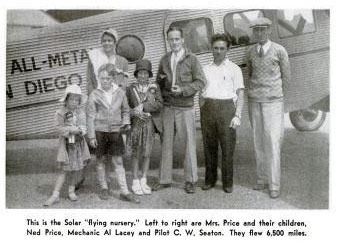 |
Or major because they made lemonade out of lemons after firm, cash-backed orders for their airplane failed to emerge as the Great Depression deepened.
Their one airplane landed once each at Clover Field (see the airplane's link above for more information and photographs) and at the Davis-Monthan Airfield, Tucson, AZ. It also landed at least 18 times at the Grand Central Air Terminal and shows up in the Register there between May and July 1931. NX258V was an all-metal airplane, and the company prided itself with its metal craftsmanship. Their metal working skill is what was leveraged to make the lemonade.
The company maintained its business through the Depression by manufacturing frying pans, baking pans and beer barrels, among other metal items. Holding the company together at these trying times was Edmund "Ned" Price, pictured at center in the photograph at left from Popular Aviation (PA) magazine. They stand in front of NX258V. Note the corrugated metal structure of the fuselage.
But their biggest market, originated and guided by Price, was developed in stainless steel exhaust systems for aircraft. The stainless steel models made by the company had their origin in the MS-1 in 1929 and 1930. Company engineers designed the exhaust system especially for that airplane and specified that it would be made of stainless. This was innovative at the time, as stainless steel was a new alloy on the market. It required considerable trial and error on the part of Solar craftsmen to learn about shaping and welding the alloy.Other aircraft manufacturers used non-stainless steels for their exhaust manifolds and mufflers. These warped, were unreliable, short-lived and dangerous if not regularly and thoroughly inspected for integrity and corrosion.
 |
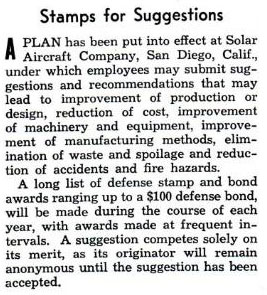 |
An article in the November, 1939 issue of Popular Aviation described the company's origins and its success through the Depression by building aircraft exhaust systems. Their customers included many of the premier aircraft manufacturers of the Golden Age including Boeing, Douglas, Consolidated and Lockheed.
A more inclusive and enrolling article appeared in a later issue of the company magazine. A copy of an historical article from the company journal, "The Solar Blast," Vol. 13, November 1952, is at the link (PDF 2.5mB). It surveys the history of the company from its inception building the MS-1 n 1930 to the beginning of WWII. The descriptions of the hard work, shoestring budgets, creative borrowing, human interest and employee loyalty are rewarding to read. This is a good primer of what it was like to keep a manufacturing company afloat during the Great Depression. The article includes photographs of the Solar factory across the decade of the 1930s. One photo shows NX258V under construction. Ned Price is featured throughout.
Below, right, courtesy of site visitor T. Radley, is a data plate from an unidentified exhaust manifold for the Consolidated Aircraft Corporation. The date is unknown, but the plate was found on the site of an old WWII airfield in England. The Model stamp on the plate looks like B-24D, which would date it to early in WWII. The Material Spec is AN 00 S 757. I searched for this spec online, but could not find it. If anyone has information, please let me KNOW. This exhaust manifold was the "Anti-Monoxide" type, alluding to its non-corrosion properties, thus preventing leaks of carbon monoxide.
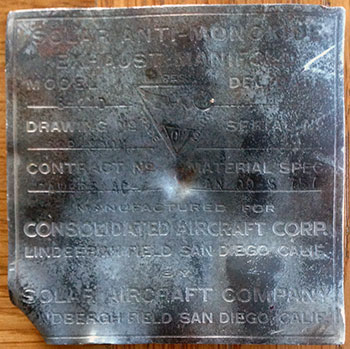 |
Solar's original order from the U.S. Navy for $500 expanded to $500,000 before the decade of the 1930s was over. An article, "Pots and Pans But No Airplanes," is available at the link (PDF 2.0Mb).
In 1939 the company had a work force of 229. During WWII the company flourished with orders from the military for 300,000 exhaust manifolds for warplanes. The workforce expanded to 5,000. The company also built a new plant in Iowa as documented in Flying magazine, July, 1942, above, right. The same issue of Flying reported that the San Diego plant initiated a defense bond giveaway for employees that offered the best recommendations for increases in wartime productivity, above, left.
Below, from Flying Magazine, August, 1943, is a wartime advertisement for Solar "Anti-Monoxide" exhaust manifolds. The tone of advertisements became more jingoistic as WWII progressed.
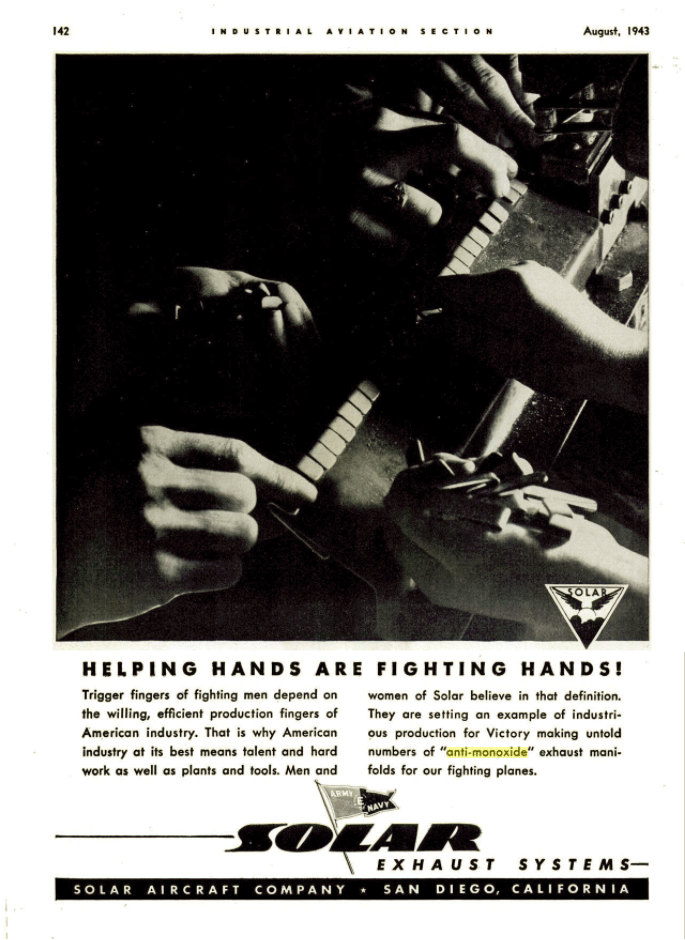 |
Equally as puzzling as the data plate is the fabric patch with the company name and logo embroidered on it, below. The logo, designed in 1930 and later trademarked, represented a rising, winged sun within a triangle.
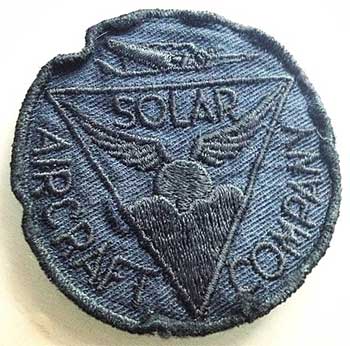 |
This patch came via England to site visitor B. See. If you can help us identify when the patch was made or what it was used for, please let us KNOW. The patch might have adorned a shop worker’s overalls, or maybe the jacket of a test pilot. What is the image embroidered on the top of the badge?
The image below is courtesy of site visitor Christopher Whitney. It is a Solar plant security badge, ca. 1940s.
 |
Below is an advertisement that appeared in Flying & Popular Aviation magazine, January, 1942. It cites the corrosion-resistant exhaust manifolds used on Consolidated amphibious aircraft.
 |
After WWII, the exhaust manifold business dropped off and they diversified again into stainless steel products like bulk milk containers and caskets. During the late 1940's it again exploited its expertise in high-temperature metallurgy to begin building small turbine engines to act as power sources either for generating electricity or running pumps or compressors. The International Harvester Company (IHC) acquired control of Solar Aircraft Company in 1960, and in 1963 the Solar Aircraft Company merged with the International Harvester Company and became the Solar Division. In 1977 the Solar Division's name was changed briefly to Solar, an International Harvester Group, then to Solar Turbines International.
In 1981, Caterpillar, Inc. purchased the assets of the Solar Division from IHC and it became Caterpillar's wholly owned subsidiary named Solar Turbines Incorporated. Today the company manufactures about a dozen models of industrial turbines yielding upwards of 30,000HP. With these turbines it also manufactures attachments that are mated with the turbines for pumping, generating or compressing. One online source estimates that Solar turbines have operated around the world, in aggregate, for over 100,000 years. An impressive statistic for a company that struggled through the Great Depression making frying pans.
---o0o---
SPONSORED LINKS
THIS PAGE UPLOADED: 07/08/14 REVISED: 07/15/14, 02/15/15, 09/07/15, 10/24/17, 11/13/17
